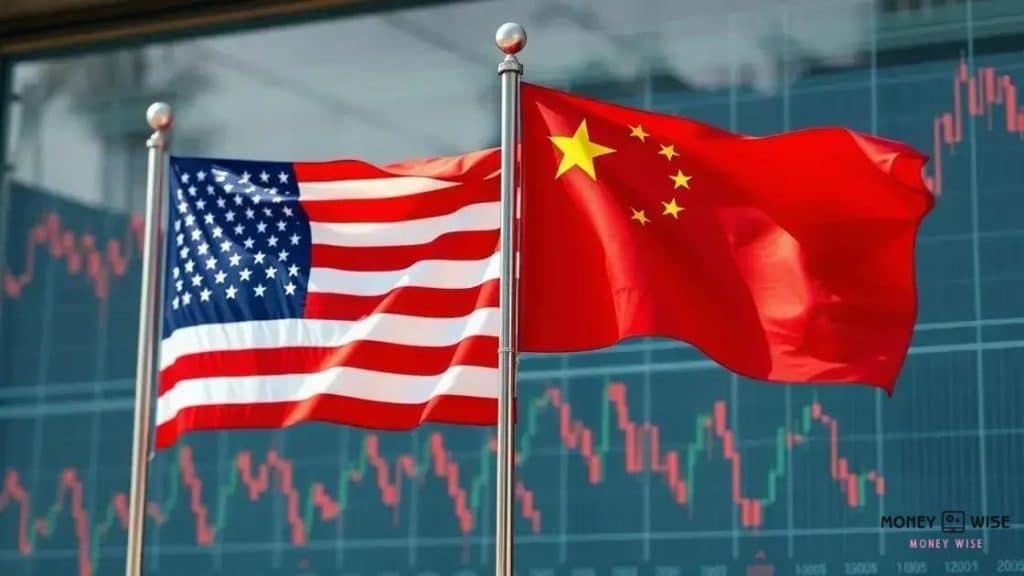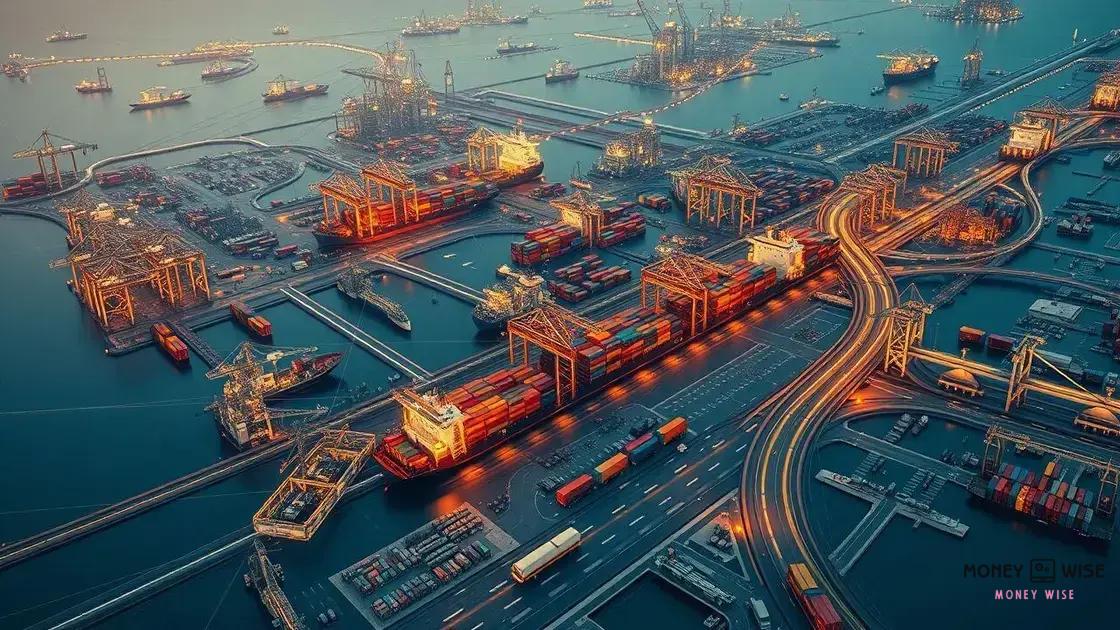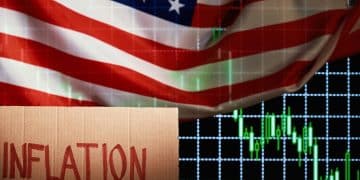US-China trade war financial impact on global economy

The US-China trade war financial impact impact on global economy has led to increased consumer prices, disruptions in global supply chains, and significant adjustments for businesses as they navigate new trade policies and changing consumer behaviors.
The US-China trade war financial impact is a topic that resonates deeply with investors and consumers alike. Have you ever wondered how these trade tensions affect your daily life and the products you use? Let’s dive in to explore the nuances behind the headlines.
Understanding the US-China trade war
The US-China trade war began in 2018 and has since created ripples across the globe. It is essential to understand the factors driving this conflict and its broader implications.
What Led to the Trade War?
Several fundamental issues triggered the trade war between these two economic giants. Key factors include:
- Trade imbalance: The US consistently ran a trade deficit with China.
- Intellectual property theft: Allegations of China stealing American technology fueled tensions.
- Manufacturing issues: Concerns over the loss of US jobs to Chinese factories.
These factors played a significant role in escalating tariffs and trade restrictions affecting various sectors.
Immediate Impacts of the Trade War
The imposition of tariffs led to various immediate economic consequences. Prices of many goods increased, impacting consumers directly in their daily purchases. For instance, electronics and agricultural products saw noticeable price hikes. Furthermore, businesses faced uncertainty, leading to stalled investments and job creation.
American farmers were especially hard-hit, as they struggled to export goods to China due to tariffs. This situation forced many to reassess their markets and methods of distribution.
Chinese businesses also faced challenges as they lost market access and gained significant pressure on their global operations. Many companies began looking for alternative markets to mitigate the risks.
Long-Term Consequences
Experts warn that ongoing tensions could reshape the global economic landscape. Companies may look to diversify supply chains to reduce reliance on any particular country.
- Supply chain adjustments: Global businesses are exploring new manufacturing locations.
- Shift in trade alliances: Countries may forge new alliances to adapt to changing trade dynamics.
- Technological decoupling: Increased focus on native technologies could emerge.
Understanding the US-China trade war is vital as it may influence how businesses operate and consumers shop in the future. The ramifications extend beyond just these two countries, forming a complex network of global trade dynamics.
As these developments continue to unfold, staying informed is crucial as the landscape of international trade evolves rapidly.
Key financial repercussions on the US economy

The key financial repercussions on the US economy from the US-China trade war are significant and multifaceted. Understanding these impacts can help us grasp how trade policies directly affect our lives.
Economic Growth Slowdown
As tariffs have increased on imported goods, the cost of products has risen. This increase can lead to a slowdown in economic growth. Consumers may reduce spending when prices rise, affecting retailers and manufacturers.
Businesses might react by postponing or cutting down on investments to prepare for uncertain market conditions. This hesitation can lead to lower job growth and fewer new opportunities.
Effects on Employment
The imposition of tariffs has influenced American jobs significantly. Several industries, especially agriculture and manufacturing, have faced hardships. Farmers have struggled as Chinese tariffs on US agricultural products have diminished their sales.
Many companies have also been forced to rethink their supply chains. Some may consider relocating production to other countries, which can result in job losses here.
- Job insecurity: Workers in affected industries may experience layoffs.
- Wage stagnation: Economic uncertainty can hinder wage growth.
- Shift to automation: Companies may invest more in technology to reduce labor costs.
These changes indicate a tough transition period for workers and families dependent on these industries.
Market Volatility
Financial markets have reacted to news related to the trade war. Investor confidence tends to fluctuate with any sign of escalating tensions. Such volatility makes it challenging to predict future investments.
As companies report earnings, many include the impact of tariffs on their bottom line, which can lead to further market reactions. Companies that rely heavily on international trade may particularly feel this pressure.
To sum up, the financial repercussions of the US-China trade war on the US economy are vast. These effects touch on individual finances, job security, and broader economic health, highlighting the interconnectedness of global trade.
Effects on Chinese businesses and consumers
The effects on Chinese businesses and consumers due to the US-China trade war are profound and complex. As tariffs increased, many industries faced unforeseen challenges that shifted the landscape of the Chinese economy.
Impact on Export Businesses
Many Chinese companies that relied heavily on exporting goods to the US experienced significant losses. Tariffs imposed by the US made Chinese products more expensive for American consumers, leading to a decline in sales.
As a result, numerous manufacturers were forced to adapt quickly to survive in a changing market. Some started to look for alternative markets, while others sought to optimize costs by investing in technology.
Changes in Consumer Behavior
Chinese consumers also felt the impact of the trade war, particularly through rising prices. Imported goods from the US, including food and electronics, became pricier due to tariffs. This shift forced consumers to reconsider their purchasing habits.
- Preference for local products: Many consumers began to favor local brands to avoid higher costs.
- Increased demand for alternatives: As prices rose, consumers looked for more affordable options.
- Decrease in luxury goods consumption: High-end imported products faced lower sales as consumers tightened budgets.
Moreover, businesses had to confront the challenge of maintaining profit margins while managing increased costs. Many companies resorted to cost-cutting measures, which sometimes translated to job cuts.
Long-Term Challenges
Looking ahead, the long-term effects include a potential shift in the supply chain dynamics. Companies are investing more in domestic production to reduce reliance on exports.
The trade tensions have also led to a strategic reassessment among businesses regarding their market positions and dependencies, prompting many to innovate and diversify their operations.
Ultimately, Chinese businesses and consumers are navigating a landscape shaped by the realities of international trade. Understanding these effects helps illustrate the interconnectedness of global economies and the challenges presented by changing trade policies.
Global supply chain disruptions due to tariffs

The global supply chain disruptions due to tariffs have reshaped how businesses operate worldwide. As the US-China trade war escalated, many companies found themselves navigating a less predictable landscape.
Impacts on Manufacturing
Manufacturers from both countries started facing delays and increased costs for their raw materials. Tariffs made goods more expensive to import and export, leading to a need for adjustments in production methods.
Some companies began to explore alternative suppliers in different countries to minimize tariff impacts. This shift sparked a realignment in the global manufacturing network.
Transportation Challenges
Transporting goods became more complex due to heightened tariff regulations. Delays in shipping and customs clearance led to stock shortages in retail stores and factories. Companies had to rethink logistics strategies to cope with uncertainty.
- Increased shipping costs: Rising fuel prices and limited shipping slots made transport expensive.
- Customs bottlenecks: Extra paperwork and inspections slowed down delivery times.
- Inventory management issues: Businesses faced challenges maintaining optimal stock levels, impacting sales.
These changes forced companies to become more agile and responsive to market needs, often investing in technology to help manage these challenges effectively.
Consumer Effects
Consumers also felt the ripple effects of disruptions in the supply chain. Product prices began to rise as companies passed increased costs onto customers. This shift led to a noticeable change in consumer purchasing behavior.
People started looking for local alternatives or products from countries that were less affected by tariffs. This trend highlights the interconnectedness of the global economy and how trade policies can influence choices at the consumer level.
Ultimately, the disruptions caused by tariffs challenge traditional business models, forcing companies to adapt and innovate. As these dynamics continue to evolve, businesses must remain vigilant and proactive in their approach to global trade.
Future implications for global trade relations
The future implications for global trade relations following the US-China trade war are expected to be significant and far-reaching. As nations navigate this new landscape, various trends are emerging that could shape international commerce.
Emerging Trade Alliances
In response to ongoing tensions, countries may start forming new trade alliances. Nations might seek stronger partnerships to mitigate risks associated with uncertainties in trade policies. This shift could lead to a more fragmented global trading system.
Countries in Southeast Asia, for example, have begun to strengthen ties with each other and with Western nations, forming coalitions that might bypass traditional superpower dynamics.
Shifting Consumer Preferences
Over time, consumer behavior is likely to evolve in response to these trade changes. People may become more conscious of where products come from, often favoring goods made locally or sourced from countries with favorable trade relations.
This shift could impact how companies market their products and the strategies they use to reach consumers. Brands that emphasize quality, ethics, and transparency may gain an edge in this new landscape.
In the end, the future of global trade relations will hinge on how effectively nations respond to evolving challenges. Businesses and consumers alike will need to adapt to a world where trade policies, economic balances, and partnerships are in constant flux.
The US-China trade war has significantly affected global economies. As we have explored, the financial impact is broad, influencing businesses and consumers worldwide. Companies are adapting by diversifying supply chains and seeking new markets.
Meanwhile, consumers are becoming more aware of where products come from and how tariffs can affect prices. Looking ahead, it is crucial to understand these changes as they will shape future trade relations. By staying informed, businesses and individuals can navigate this evolving landscape more effectively.
FAQ – Frequently Asked Questions about the US-China Trade War Financial Impact
What is the main impact of the US-China trade war on consumers?
Consumers are facing higher prices for many goods due to tariffs, which can limit their purchasing options and increase spending.
How has the trade war affected businesses?
Businesses are experiencing increased costs for raw materials and may need to realign their supply chains to avoid tariffs.
What changes can we expect in global trade relationships?
We can expect new trade alliances to form as countries seek to navigate the changing landscape and reduce reliance on any one market.
How are companies adapting to the effects of the trade war?
Many companies are diversifying their suppliers, investing in technology, and adjusting their marketing strategies to respond to shifts in consumer behavior.
Will the trade war have long-lasting effects?
Yes, the trade war is likely to have lasting effects on global supply chains, trade policies, and consumer habits as nations adapt to new economic realities.





